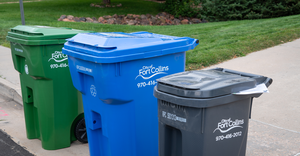Will California Reach its Pending Organics Diversion Goals?
The ability to move forward on what is arguably the country’s largest food scrap collection and processing system has hinged on government public-private sector partnerships. CalRecycle Director Rachel Machi Wagoner wrote Waste360 detailing progress to date; funding that’s gone into this hardball food waste fight; and support to jurisdictions in implementing programs and overcoming compliance barriers.

California has one year left to hit two ambitious targets set by SB 1383: a 75 percent statewide reduction in organic waste disposal and redirecting 20 percent of edible, unsold food to people in need that would otherwise be trashed.
CalRecycle Director Rachel Machi Wagoner wrote Waste360 detailing progress to date; funding that’s gone into this hardball food waste fight; and support to jurisdictions in implementing programs and overcoming compliance barriers.
California’s next organics material composition study should unveil a more comprehensive picture in 2025.
But for some of the concrete numbers on the books today:
75 percent of jurisdictions now report residential organics collection (464 of the 616 jurisdictions).
From 2014 to 2021, before SB 1383 took effect, organics disposal dropped from 21 million tons to 19 million tons.
Organics diverted for recycling climbed from 9.9 million tons in 2021 to 11.2 million tons in 2022—the year SB 1383 kicked in.
On the unsold food front, supermarkets and food service businesses must recover 231,000 tons of good edibles to meet the 2025 target. Collectively jurisdictions report they rescued nearly 203,000 tons of unsold food in 2022; that’s 87 percent of the way to the goal. Even with decent headway, California still landfills 2.5 billion meals worth of unsold food every year.
Anecdotally, Wagoner writes: “California is rapidly building and expanding organics infrastructure as part of the SB 1383 implementation process. Jurisdictions have not reported to CalRecycle a lack of capacity will be a problem. County capacity plans did not express concerns about major gaps in existing, planned, or expanded capacity.”
In recent years, California has seen an infrastructure growth spurt, with CalRecycle issuing permits for seven solid waste facilities from October 2022 to December 2023 alone that included new compost, in-vessel digestion, and transfer/processing facilities. Today the state is home to 210 operating organics processing facilities, including 169 composting facilities, 17 anaerobic digestion facilities with 21 more under construction, and 24 biomass operations.
Plenty more infrastructure has to roll out to take on the massive waste volumes landfills will no longer accept.
CalRecycle estimates 50 to 100 new or expanded anaerobic digestion facilities must come online to help handle the organics load while also facilitating delivery of clean fuels.
Dan Noble, executive director of the Association of Compost Producers, the California chapter of the US Composting Council, estimates compost production capacity must double— to roughly 10-12 million tons—to reach the scale needed for compost to do its part in meeting SB 1383 requirements.
“We are well on our way already... so it's boom time for the compost industry. Facility expansion and new facilities have been going in all over the state, and more will continue to go in as we grow over the next several years,” Noble says.
Wagoner sees good justification both from a compliance and product demand perspective; California grows one-third of the nation’s vegetables and two-thirds of its nuts and fruit.
Compost facilities have told CalRecycle that they sell out every year and cannot produce enough product to serve their areas, she says.
Not everyone watching how the Golden State’s organics management landscape plays out is optimistic.
The Little Hoover Commission, a state oversight agency, said last year the attainment of 75% organics diversion by 2025 is "in doubt."
California still has a way to go to reach goals outlined under SB 1383, confers Dylan Chase, RNG Coalition public relations manager.
“That said, progress is rarely a straight line. Several of our members have planned digester projects in California that the state is hopefully doing everything in its power to support. We cannot let doubt constrain our reach,” Chase says.
Tackling food waste in the country’s most populous state is no cheap endeavor. California has committed $487 million to organics recycling and surplus food recovery grants and loans to support SB 1383, most recently (in December 2023) awarding $130 million for 23 projects to convert organics into compost, renewable transportation fuel, and clean power. The projects, spanning 15 counties, are projected to divert 7.7 tons of food and yard waste; cut pollution equal to taking over 480,000 cars off the road; and create 114 jobs.
Other funding includes:
$237.4 million in organics grants since FY 2014-2015.
$29 million for fresh unsold food rescue projects starting in FY 2016-2017, which so far have provided over 246 million meals to Californians in need.
$56.6 million in SB 1383 Local Assistance Grants since FY 2021-2022 to support local program compliance, with another $109 million to be awarded in 2024.
$23 million from the Co-Digestion Grant Program to six water agencies and sanitation districts.
$21 million in Recycling Market Development Zone and Greenhouse Gas Reduction loans.
$5.7 million in Community Composting for Green Spaces grants since FY 2019-2020, with $510,000 more to be awarded in 2024.
Jurisdictions hard pressed to meet impending demands have been given some leeway. For instance, regulations allow for collection waivers to avoid disproportionate financial costs to some communities, such as in rural and low-population regions. And some communities were granted more time to meet requirements to procure products made from recovered organic waste.
The ability to move forward on what is arguably the country’s largest food scrap collection and processing system has hinged on government public-private sector partnerships, with government money being a part of it, Wagoner says.
“Nearly half-a-billion in funding from the legislature has seeded infrastructure investments from the private sector to advance California’s circular economy for organics. Reaching California’s organics climate pollution goals requires government, private industry and all Californians working together.”
About the Author
You May Also Like




